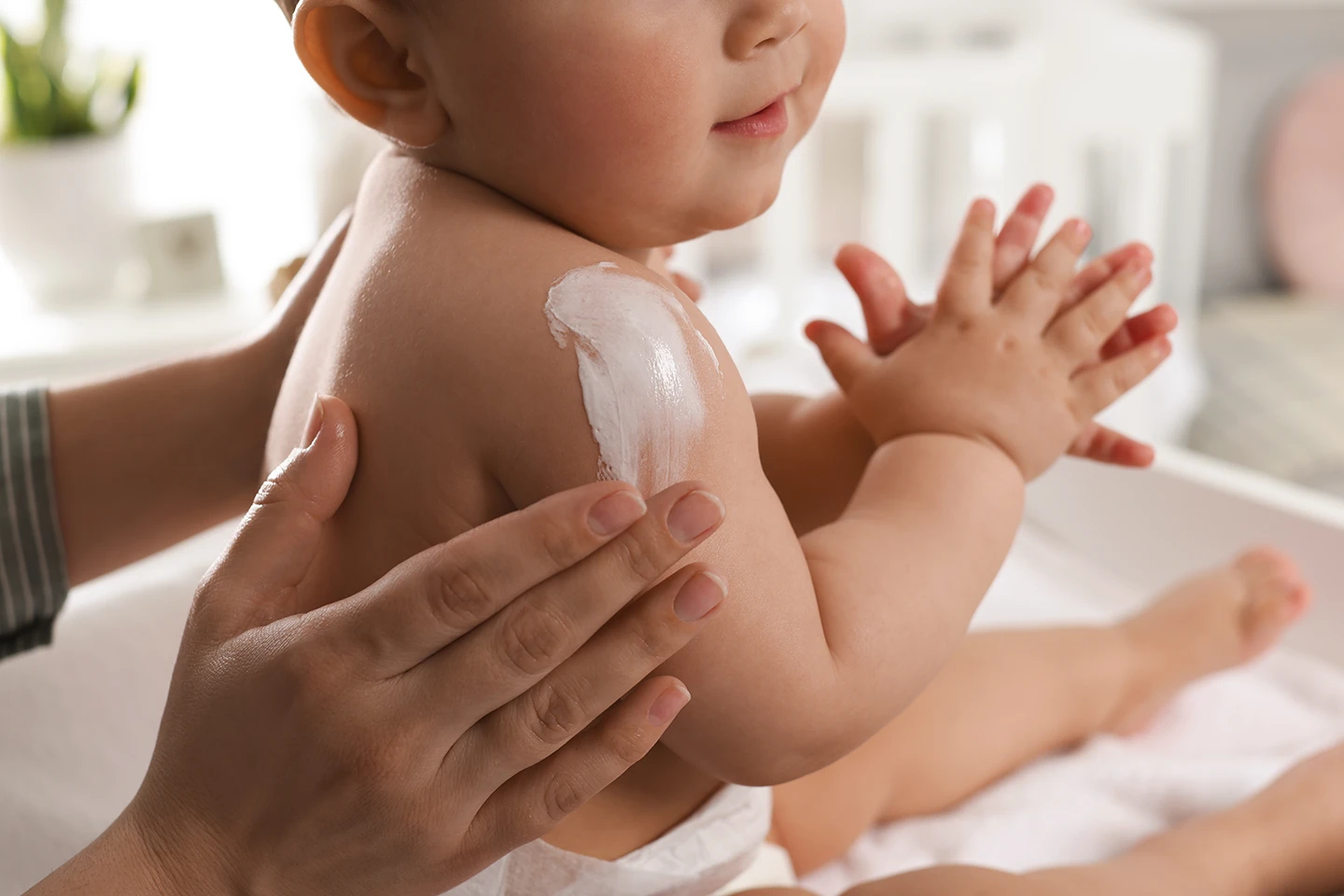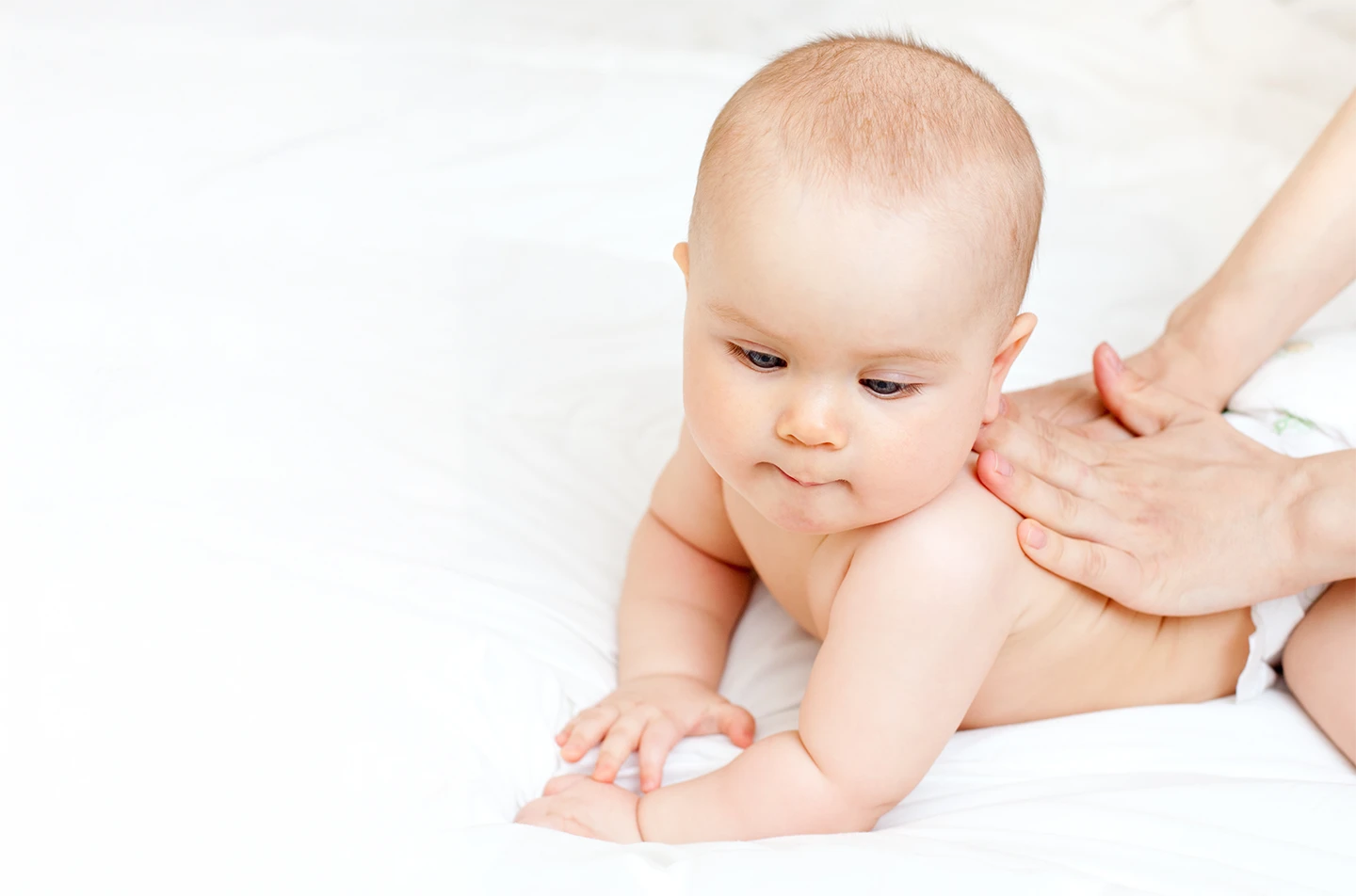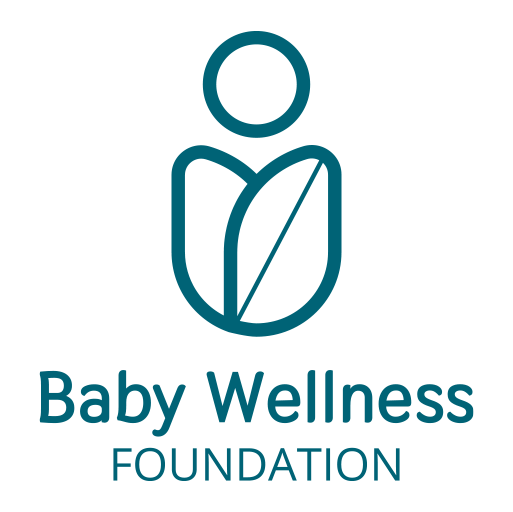Approfondimenti scientifici
Skin wellness
The newborn comes into the world wrapped in its skin, just like us, but for them everything is a completely new experience. For us, skin is a familiar envelope, a natural boundary that protects us and lets us feel. We are used to living our emotions and pleasure through it. For the newborn, all this is almost a first encounter, even though, in reality, it is never entirely new.
Already while in the womb, the fetus perceives the world through the skin: it feels the presence of the uterine walls and discovers its own hand, sucking it as a way of exploring itself. This gesture is more than simple curiosity, it is an act of self-knowledge, a deep connection with oneself. Touch can offer this unique experience, allowing the newborn to perceive both the “self” and the “other.”
While in the womb, the newborn is enveloped in a protective environment: the amniotic fluid supports it and cushions every impact, while the vernix caseosa preserves the skin from direct contact with the liquid. Moreover, the mother’s body offers protection against temperature fluctuations. When the baby is born, it doesn’t just “change skin”; everything around it transforms radically.
It comes into the light, begins to breathe, to feed, and to set its organs in motion: the eyesight, the lungs, and the digestive system, which had already had their first trials in the maternal womb. The skin also undergoes a rapid transformation, adapting to the new world. It is a moment of profound change, where every aspect of its life is activated, ready for exploration and discovery.
Skin is, above all, an extraordinary envelope, a unique and perfect container. It works like a “thermal suit,” made with resistant fabric, able to protect us not only from heat and cold but also from trauma, without forgetting its function of regulating water loss. It is truly rare for newborn skin to show “manufacturing defects”; one could say it is practically flawless.

Skin as a tool of knowledge
From the very beginning, the newborn uses the skin as its main tool to explore the world. It is a bit like a “blind mole”: it perceives stimuli, but cannot yet give them meaning. Its main senses are the elementary ones, such as smell, taste, and touch, which allow it to connect with its surroundings.
DID YOU KNOW…
The sense of touch begins to develop around the 8th week of pregnancy. At this stage, the fetus begins to form nerve endings in the skin, and around the 14th week, touch becomes increasingly sensitive. By the third trimester, the skin is able to perceive external stimuli significantly, preparing the fetus to interact with the world after birth.
Did you know? Bath time is a special moment to stimulate the sense of touch in newborns and children.
These moments, along with daily gestures of hygiene and hydration, offer the perfect opportunity to explore the sense of touch. Water, but also soft surfaces, can foster a special bond between parent and child. Moreover, contact with water and the textures of wellness products for the newborn can support and develop the child’s tactile sensitivity. Tactile information helps us better understand the world around us! This “sensory, emotional, and motivational dimension” allows us to recognize and distinguish different characteristics of objects, such as their shape, texture, and temperature. In this way, touch makes our daily experiences richer and more enjoyable, allowing us to interact more safely and playfully! (D. Hubel & T. Wiesel: Brain and Visual Perception 2004).
Skin is an extraordinary and complex organ that covers the entire body, performing several crucial functions:
- Protective barrier: skin acts as a barrier, protecting the body from external agents such as bacteria, viruses, and harmful substances.
- Temperature regulation: through sweating and dilation or constriction of blood vessels, skin helps maintain a constant body temperature, adapting to environmental variations.
- Sensitivity: thanks to numerous nerve endings, skin can perceive touch, pain, temperature, and vibrations, enabling interaction with the surrounding environment.
- Immune function: skin contains immune cells that help defend the body against infections, activating immune responses when attacked by pathogens.
- Vitamin D synthesis: when exposed to sunlight, skin is involved in synthesizing vitamin D, essential for bone health and proper immune system function.
The newborn’s skin has a distinctive and delicate structure, different from that of adults. Here are the main characteristics:
- Epidermis: this layer is particularly thin and immature, with limited protective capacity. It is here that the cells forming the skin barrier develop.
- Dermis: thicker than the epidermis, it contains blood vessels, hair follicles, sweat and sebaceous glands. The newborn’s dermis is still developing and maturing.
- Hypodermis: this subcutaneous layer is mainly composed of adipose tissue, which plays a crucial role in insulation and energy storage.

The newborn’s skin has some distinctive characteristics that make it unique
- Newborn skin is much thinner than that of adults, which makes it more vulnerable to irritation and injury. The stratum corneum begins to develop at 15 weeks of gestational age, and this process ends around 34 weeks of gestational age. Newborns have a stratum corneum that is 30% thinner than that of adults.
- The layers of the skin, particularly the epidermis, are still developing and do not yet offer complete protection against external agents.
- After birth, it is common to find a white, creamy substance on the newborn’s skin. This layer, known as vernix caseosa, acts as a protective and moisturizing barrier.
Vernix caseosa is a bit like the newborn’s skin protector. It is a whitish substance formed from sebaceous secretions and epidermal cell debris, and it does many important things: for example, it protects against bacteria and keeps the newborn’s skin at a pleasant temperature, just like a warm hug! This fantastic coating begins to form between the 17th and 20th week of pregnancy and becomes increasingly thicker between the 36th and 38th week. Hey, but don’t forget: when bath time arrives, it should not be removed, as it is essential for the newborn’s well-being! (J-P. Willoughby, Pediatric Dermatology, 2011).
- The newborn’s adipose tissue plays a fundamental role as a thermal insulator and energy reservoir. This tissue helps maintain body temperature, protecting the newborn from thermal variations in the external environment. The deposition of subcutaneous fat begins to develop around the third month of pregnancy. During this stage, the fetus accumulates fat, which not only contributes to thermoregulation but also acts as an energy reserve. This is particularly important for newborns, as subcutaneous fat supports growth and development in the first weeks of life, when the newborn is still adapting to the extrauterine environment.
- Newborn skin is sensitive and reactive, making skin-to-skin contact particularly important for its emotional and physical development.
- At birth, a newborn’s skin tends to be purple or red, due to the effort caused by labor. After about one or two days, the newborn’s skin color changes, taking on a pinkish tone. Only in the following six months will the child’s true skin color develop, based on genetic characteristics.
- Children’s skin is more sensitive to UV rays than that of adults.
- Sensitivity to UV rays is further increased by the low pigmentation of children’s skin. Melanocytes (the cells responsible for producing melanin) are present, but less active.
- The sebaceous and sweat glands are present, but their function is not yet fully developed. This can lead to skin that dries out more easily.
- Despite its vulnerability, newborn skin has a remarkable capacity for regeneration and healing.
- During the first months of life, these glands do not function optimally, which means they produce less sebum compared to adults. This leads to a thinner hydrolipidic film on the skin, making it more vulnerable to dryness and irritation. Over the first few months, sebaceous glands begin to develop and function better. However, they do not reach full activity until the onset of puberty, when hormones begin to stimulate them. Therefore, it is important to care for newborn skin with moisturizing and nourishing products to support this stage of development.
- Newborns mainly have eccrine sweat glands (a type of gland present in the skin, playing a fundamental role in regulating body temperature), which are active from birth. Apocrine glands (a type of sweat gland that develops in certain areas of the body, such as the armpits, genital area, and scalp) develop later and are linked to body odors; they are not yet functional in newborns and infants. And that’s exactly why newborns always smell so delicious!

Attention to the pH of newborn skin
As weeks go by, skin pH tends to become more acidic (between 6.0 and 7.0), typically stabilizing between 4.5 and 5.5. This process is crucial for skin health, as a more acidic pH helps maintain the balance of the dermobiota on the skin, promoting the growth of beneficial bacteria and inhibiting the proliferation of harmful pathogens. In addition, proper pH strengthens the skin barrier, making it more resistant to infectious agents and environmental irritants. The maturation of the skin barrier is therefore a fundamental aspect in the first months of the newborn’s life. During this period, it is essential to pay attention to skin care, using gentle and suitable products, avoiding harsh chemicals, to ensure proper hydration and protection. Adequate care not only helps preserve skin health but also promotes optimal development of the newborn in its environment. Simply put, skin pH plays an important role in maintaining its balance. The acid mantle is the key to the protective skin barrier. It neutralizes aggressive alkaline substances (such as harsh surfactants), inhibits bacterial proliferation, and restores and maintains the ideal acidic environment in which the skin’s natural flora can develop.
Skin pH is a measure of the acidity or alkalinity of the skin’s surface, expressed on a scale from 0 to 14. A pH of 7 is considered neutral; values below 7 indicate acidity, and above 7 indicate alkalinity. Human skin normally has a pH between 4.5 and 5.5, which makes it slightly acidic. This acidity is important to maintain the skin barrier, protect against bacteria and pathogens, and promote skin health.
Hydrolipidic film and Natural Moisturizing Factor (NMF) in newborn skin
The Natural Moisturizing Factor (NMF) is a set of substances naturally found in the skin, particularly inside cells called corneocytes. Corneocytes are located in the outermost layer of the epidermis, called the stratum corneum. This layer is composed of cells that have flattened and become rich in keratin, a protein that gives the skin strength and impermeability. Corneocytes form a protective barrier that helps maintain skin hydration and defend it from external agents such as bacteria and chemicals. In short, corneocytes are essential for skin health and integrity.
The NMF is fundamental for keeping newborn skin hydrated, as it attracts and retains water.
Where NMF is found in newborn skin:
- inside corneocytes: in newborns, NMF is located inside corneocytes, helping to maintain an adequate level of moisture, essential for their delicate skin.
- on the surface of the epidermis: here it is part of the hydrolipidic film or acid mantle.
Hydrolipidic film
The hydrolipidic film is a thin layer covering the newborn’s skin and performs several important functions:
- protection: it helps defend the skin from bacteria and irritating substances present in the environment.
- hydration: it keeps the skin hydrated by retaining water. The presence of NMF is crucial, as it helps capture environmental moisture.
- pH regulation: the acid mantle maintains a slightly acidic pH, important for skin health and protection against germs.
Let’s remember that the Natural Moisturizing Factor is essential to keep newborn skin healthy and well hydrated. The hydrolipidic film, which includes the NMF, creates a protective barrier that helps preserve moisture and defend delicate skin from external factors. This is particularly important in the first months of life, when the skin is still developing and needs extra care.
Lipids help form the hydrolipidic film, a protective layer on the skin’s surface. This film helps maintain hydration, preventing water loss and protecting the skin from external agents. Lipids are essential for the skin’s barrier function. They help prevent bacteria and irritating substances from entering, reducing the risk of infections and inflammation. They are fundamental for keeping the skin soft and elastic.

Why is sebum so important for newborn skin?
Newborn skin sebum is an oily substance produced by sebaceous glands, which are located in the skin. Even though sebaceous glands in newborns are not yet fully developed, sebum helps keep the skin hydrated, forming a barrier that reduces water loss and maintains skin elasticity. In addition, it acts as a natural barrier against bacteria and external agents, helping prevent infections and irritation. It also contributes to maintaining an adequate skin temperature, protecting against dehydration and cooling (L. A. Schachner & J. Tharp, Pediatric Dermatology, 2003).
Why does newborn skin tend to dehydrate?
Children’s skin has a particular ability to store water quickly, but it is also more prone to loss. This phenomenon is partly due to the lower presence of natural moisturizing factors in the outer layers of the skin, especially during the first year of life. Therefore, children’s skin tends to dehydrate.
Newborn skin may also dry out quickly for other reasons:
- Immaturity of sebaceous glands: sebaceous glands in newborns are not yet fully developed, so they produce less sebum, a substance that helps keep the skin hydrated.
- Thin hydrolipidic film: newborn skin has a thinner hydrolipidic film, which makes it less protected from water loss and more susceptible to dryness.
- Environment: newborn skin is exposed to environmental factors such as dry air or high temperatures, which can contribute to skin dehydration.
- Frequent baths: if newborns are washed too often or with harsh products, their skin can lose further moisture.
- Lack of hydration: newborn skin requires constant hydration to maintain its balance, and without proper care, it can dry out easily.
The dermobiota of newborn skin refers to the community of microorganisms, such as bacteria and fungi, that colonize the child’s skin. This microbial community plays a crucial role in the development of the immune system and in protecting the skin from harmful pathogens.
Environmental pollution represents a serious threat to the health of newborn and children’s skin. The skin of little ones is particularly sensitive and vulnerable, making them more susceptible to the harmful effects of pollutants. Here are some key aspects to consider. Newborn skin is thinner and more permeable than adult skin. This means pollutants can penetrate more easily, increasing the risk of irritation and allergies. Exposure to pollutants such as fine dust, heavy metals, and chemicals can cause skin irritation, dermatitis, and other allergic reactions. These problems can appear as redness, itching, and dryness of the skin. Pollution can alter the skin’s microbial flora, compromising its natural defenses and making children more vulnerable to infections. Prolonged exposure to pollutants can have cumulative effects, contributing to skin problems even in adulthood. It is important to pay attention to how pollution can affect skin health in the long term. To protect children’s skin, it is essential to reduce exposure to pollutants. This may include the use of skin care products free from harsh chemicals, adopting good hygiene practices, and limiting time spent outdoors during periods of high air pollution.
6 simple rules for newborn and child skin well-being
- Cleanse gently: newborn skin is less dirty than that of adults and does not need frequent cleaning. Use a gentle cleanser based on plant ingredients, which are emollient and nourishing. Newborn skin is generally less dirty than that of adults for various reasons. Newborns, especially in the first months, are less active and therefore less exposed to situations that could lead to dirt, such as outdoor play. It produces less sebum, an oily substance that can trap dirt and impurities. This helps keep the skin cleaner.
- Choose a specific shampoo: the newborn’s hair and scalp are very delicate. Opt for a shampoo formulated for newborns, which ensures gentle cleansing and nourishment. If there are crusts on the scalp, you can use a shampoo designed for this need.
- Pay attention to intimate hygiene: protect the urogenital area from irritation. At each diaper change, use a specific intimate cleanser for newborns, formulated with natural ingredients, to maintain protective pH.
NEWS: Zinc paste is particularly suitable for treating the diaper area for several reasons. Zinc has soothing effects that help reduce irritation and redness of the skin, common in the diaper area. It forms a protective barrier on the skin, reducing direct contact with moisture and irritating substances present in the diaper, such as urine and feces. - Do not overdo baths: in the first six months, one or two baths per week are sufficient. In summer, you can give a few more baths. After six months, increase the frequency. Room temperature should be between 21 and 22°C, while water should be at 36–37°C.
- Moisturize after each cleansing: after bathing, apply an oil or lotion to keep the skin hydrated. Also, after each diaper change, use a gentle nourishing product to prevent irritation.
- Choose safe laundry products: for cleaning newborn clothes, it is recommended to use non-allergenic detergents with high skin tolerance. Avoid over-disinfecting laundry, as product residues can cause irritation and dermatitis. Some products commonly used by adults can be harmful to newborns. Ingredients such as alcohol, parabens, and phenoxyethanol can irritate children’s delicate skin or cause allergic reactions. It is essential to opt for products specifically formulated for infants, free from harsh chemicals and dermatologically tested, to ensure maximum safety and protection for newborns’ sensitive skin.
Parabens are widely used preservatives, once considered among the safest. However, some of these substances can be absorbed through the skin, causing irritation, dermatitis, and allergies in the medium to long term. The use of parabens is prohibited in leave-on products intended for the diaper area, such as diaper creams (Official Journal of the European Union, September 18, 2014). It is important to choose paraben-free products to ensure the safety and health of newborns’ delicate skin.
